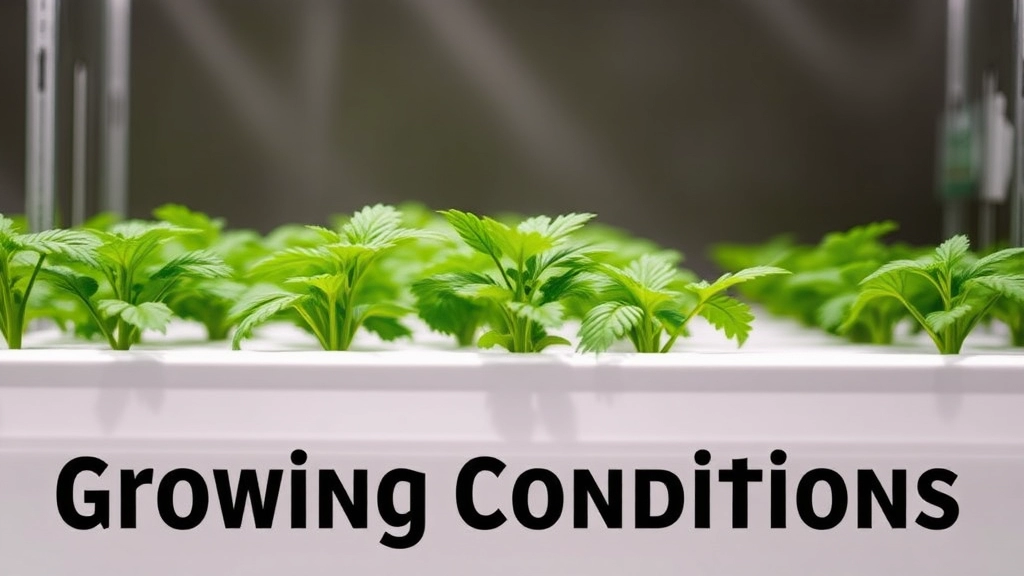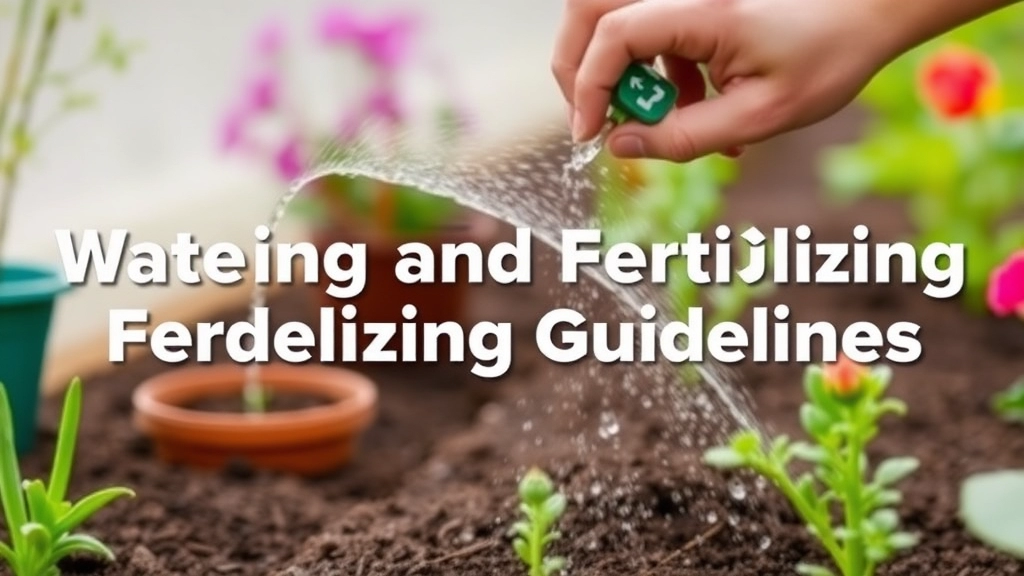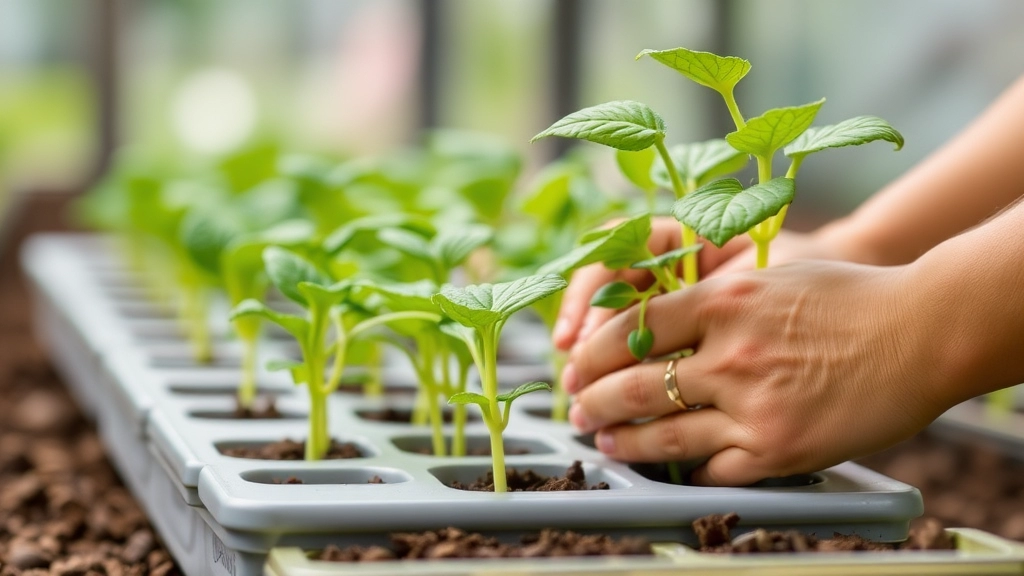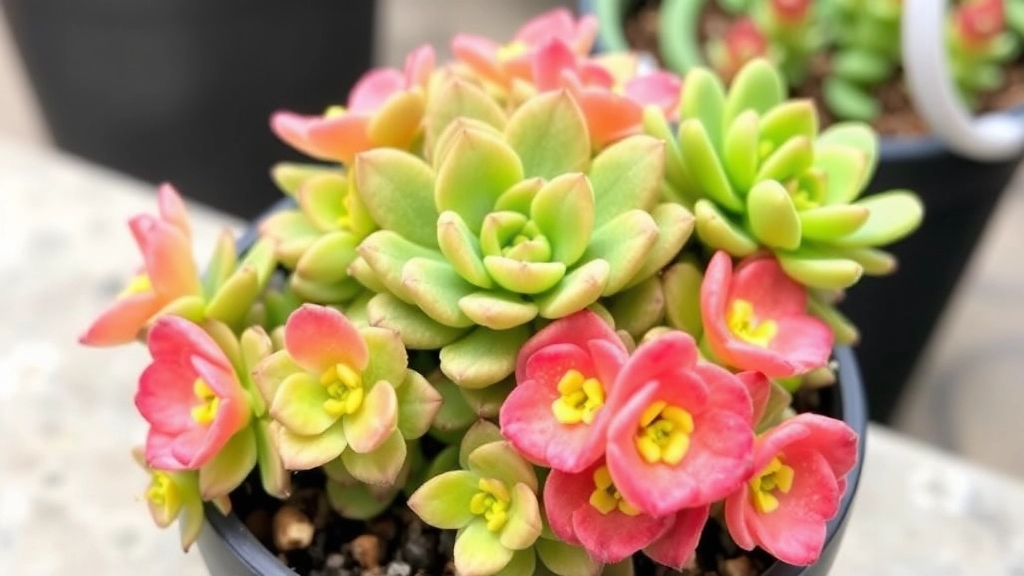Caring for Kalanchoe Flapjacks Succulent Plant
Ever wondered how to care for a Kalanchoe Flapjacks Succulent Plant? You’re in the right place. This unique plant, known for its striking, paddle-shaped leaves, can be a stunning addition to your home garden. I’ll share some practical tips to help you keep your Kalanchoe Flapjacks healthy and thriving.
From watering schedules to sunlight needs, understanding the basics of Kalanchoe Flapjacks care is essential. Let’s dive into the specifics and ensure your succulent stays vibrant and lush all year round.
When considering houseplants that are both visually striking and easy to care for, Kalanchoe Flapjacks often comes to mind.
These succulent plants, also known as Kalanchoe luciae, are characterised by their distinctive, paddle-shaped leaves that can grow up to 15 cm long.
Key Features:
– **Leaf Structure**: The leaves are thick and fleshy, with a vibrant green hue that can develop red edges when exposed to bright sunlight.
– **Growth Habit**: Kalanchoe Flapjacks typically grow in a rosette formation, making them a compact addition to any indoor or outdoor space.
– **Flowers**: While the focus is often on the foliage, Kalanchoe Flapjacks can produce clusters of small, tubular flowers in shades of pink or yellow, usually during the spring.
– **Size**: These plants can reach a height of about 30 cm, making them suitable for various settings, from tabletops to garden beds.
– **Hardiness**: As a succulent, Kalanchoe Flapjacks are drought-tolerant and thrive in arid conditions, making them perfect for busy individuals or those new to gardening.
Understanding these characteristics helps in appreciating why Kalanchoe Flapjacks are a popular choice among plant enthusiasts. For more detailed care tips, you may want to check out this [expert guide on Kalanchoe Flapjack care](https://planthq.org/how-to-care-for-kalanchoe-flapjack-expert-tips/). Additionally, if you’re interested in propagating this beautiful plant, here’s a [step-by-step guide on Kalanchoe leaf propagation](https://planthq.org/kalanchoe-leaf-propagation-stepbystep-guide-for-success/).
Ideal Growing Conditions

So, you’re keen on growing Kalanchoe Flapjacks, huh? Let’s dive into what these beauties really need to thrive.
Light
First off, light is key. Kalanchoe Flapjacks love bright, indirect sunlight. Too much direct sun can scorch those lovely leaves, while too little light can stunt their growth.
Temperature
Next up is temperature. These plants are pretty chill but prefer a warm environment. Aim for temperatures between 18°C to 24°C (65°F to 75°F). Keep them away from drafty windows or cold spots.
Humidity
Humidity? Not a biggie for Kalanchoe Flapjacks. They’re a succulent, so they thrive in low humidity. If you live in a humid area, don’t worry; just ensure good airflow around your plant.
Soil
Now, let’s talk soil. A well-draining soil mix is essential. You can use a cactus or succulent mix or even make your own with:
- Potting soil
- Perlite
- Sand
This combo helps prevent root rot, which is a common issue with succulents.
Potting
And don’t forget about the pot! Choose a pot with drainage holes to let excess water escape. Terracotta pots are a great option because they wick moisture away, keeping the roots happy.
Summary
In short, Kalanchoe Flapjacks thrive in bright, indirect light, warm temperatures, low humidity, and well-draining soil.
Planting and Potting Tips for Kalanchoe Flapjacks
When it comes to planting Kalanchoe Flapjacks, many enthusiasts often wonder about the best practices to ensure their succulent thrives.
Watering and Fertilizing Guidelines

When it comes to caring for your Kalanchoe Flapjacks, getting the watering and fertilizing right is crucial. Many plant enthusiasts often worry about overwatering, which can lead to root rot, or under-watering, which can stunt growth. Let’s break down the essentials to ensure your plant thrives.
Watering Tips
- Frequency: Water your Kalanchoe Flapjacks every 2-3 weeks, allowing the soil to dry out completely between waterings.
- Method: Use the soak-and-dry method. Water thoroughly until you see excess drainage from the bottom, then let it dry out.
- Signs of Needs: If the leaves start to wrinkle, it’s a clear sign your plant needs water. Conversely, yellowing leaves can indicate overwatering.
Fertilizing Guidelines
- Type of Fertilizer: A balanced, water-soluble fertilizer with equal parts nitrogen, phosphorus, and potassium works best.
- Frequency: Fertilize your Kalanchoe Flapjacks every 4-6 weeks during the growing season (spring and summer).
- Dilution: Always dilute the fertilizer to half the recommended strength to avoid burning the roots.
By following these watering and fertilizing guidelines, you’ll help your Kalanchoe Flapjacks flourish.
As you nurture your Kalanchoe Flapjacks, you might find yourself wondering about potential threats to its health.
### Common Pests:
– **Mealybugs**
– Small, white, cotton-like insects.
– They suck sap from the plant, leading to yellowing leaves.
– Treatment: Wipe them off with a cotton swab dipped in rubbing alcohol.
– **Aphids**
– Tiny, green insects that cluster on new growth.
– They can distort leaves and stunt growth.
– Treatment: Spray with insecticidal soap or neem oil.
– **Spider Mites**
– Tiny, spider-like pests that thrive in dry conditions.
– Look for fine webbing on the undersides of leaves.
– Treatment: Increase humidity and use insecticidal soap.
### Common Diseases:
– **Leaf Spot**
– Caused by fungal infections, leading to dark spots on leaves.
– Treatment: Remove affected leaves and ensure good air circulation.
– **Root Rot**
– Occurs when the plant is overwatered, leading to mushy roots.
– Treatment: Repot in fresh, dry soil and reduce watering frequency.
– **Powdery Mildew**
– A white, powdery fungus that appears on leaves.
– Treatment: Improve air circulation and use a fungicide if necessary.
For more detailed guidance on pest management, you can refer to [how to treat and prevent kalanchoe white bugs](https://planthq.org/how-to-treat-and-prevent-kalanchoe-white-bugs/) and for comprehensive care tips, check out [caring for your kalanchoe succulent](https://planthq.org/caring-for-your-kalanchoe-succulent-a-complete-guide/).
Propagation Methods

So, you’re keen to expand your Kalanchoe Flapjacks collection? Great choice! Propagating these beauties is not only easy but also super rewarding.
Here’s how you can do it:
- Leaf Cuttings:
- Snip a healthy leaf from the parent plant.
- Allow it to dry for a couple of days to form a callus.
- Place it on well-draining soil and lightly press it down.
- Keep it in a warm spot and mist occasionally.
- Offsets:
- Kalanchoe Flapjacks often produce little offsets (baby plants) around the base.
- Gently separate them from the parent plant.
- Replant in their own pots with similar soil.
- Seeds:
- If you’re feeling adventurous, you can try growing from seeds.
- Scatter seeds on the soil surface and mist lightly.
- Keep them in indirect sunlight until they sprout.
Tips to Keep in Mind:
- Always use clean tools to prevent disease.
- Be patient! It can take a few weeks for new growth to appear.
- Ensure the new plants get plenty of light but avoid direct sun at first.
Propagation is a fantastic way to not only multiply your collection but also share the joy with friends.
Seasonal Care and Maintenance of Kalanchoe Flapjacks
As we dive deeper into the care of Kalanchoe Flapjacks, it’s essential to consider how seasonal changes impact their growth and overall health.
Spring: Revitalisation and Growth
Spring is the season of rejuvenation for your Kalanchoe Flapjacks.
- Light: Ensure they receive plenty of bright, indirect sunlight to promote robust growth.
- Repotting: If your plant has outgrown its pot, spring is the perfect time to repot it into a slightly larger container.
- Fertilising: Start a fertilising routine. Use a balanced, water-soluble fertiliser every 4-6 weeks to encourage new growth.
Summer: Care in the Heat
As temperatures rise, your Kalanchoe will need some extra attention.
- Watering: Increase watering frequency, but ensure the soil dries out between waterings to prevent root rot.
- Humidity: Keep an eye on humidity levels. Kalanchoe Flapjacks prefer drier conditions, so avoid placing them in overly humid spots.
Autumn: Preparing for Dormancy
As autumn approaches, it’s time to prepare your plant for the upcoming dormancy period.
- Reduce Watering: Gradually decrease watering as the plant’s growth slows down.
- Light Adjustment: Ensure it still receives adequate light but be mindful of any sudden temperature drops.
Winter: Minimal Care
During winter, Kalanchoe Flapjacks enter a dormant phase.
- Water Sparingly: Only water when the soil is completely dry. This helps prevent overwatering during the colder months.
- Temperature: Keep them in a warm environment, ideally above 10°C. Avoid cold drafts.
Decorative Uses and Benefits of Kalanchoe Flapjacks
Have you ever wondered how to elevate your home decor with a touch of nature? Kalanchoe Flapjacks might just be the answer you’re looking for.
These stunning succulent plants not only add a splash of colour but also bring a unique texture to your indoor and outdoor spaces.
Aesthetic Appeal
- Vibrant Colours: Their fleshy, pancake-like leaves boast shades of green, red, and even purple.
- Unique Shape: The flat, round leaves create an eye-catching display, making them a conversation starter.
- Versatile Placement: Whether on a windowsill, coffee table, or in a garden, they fit right in.
Benefits Beyond Beauty
- Air Purification: These plants can help improve indoor air quality by filtering toxins.
- Low Maintenance: Perfect for busy folks, they require minimal care while still looking fabulous.
- Caring Vibes: Having plants around can boost your mood and reduce stressâwho doesn’t want that?
Creative Uses
- Terrariums: Pair them with other succulents for a stunning mini-garden.
- Gift Ideas: A potted Kalanchoe Flapjack makes a thoughtful gift for plant lovers.
- Table Centrepieces: Use them to brighten up dining tables or special events.
FAQs About Kalanchoe Flapjacks Succulent Plant
What are the ideal light conditions for Kalanchoe Flapjacks?
Kalanchoe Flapjacks thrive in bright, indirect sunlight. Too much direct sun can scorch their leaves, while too little light can stunt their growth.
What temperature range is best for Kalanchoe Flapjacks?
These plants prefer a warm environment with temperatures between 18°C to 24°C (65°F to 75°F). Avoid placing them near drafty windows or cold spots.
Do Kalanchoe Flapjacks require high humidity?
No, Kalanchoe Flapjacks are succulents and thrive in low humidity. Ensure good airflow around the plant if you live in a humid area.
What type of soil should I use for Kalanchoe Flapjacks?
A well-draining soil mix is essential. You can use a cactus or succulent mix, or make your own with potting soil, perlite, and sand to help prevent root rot.
How often should I water my Kalanchoe Flapjacks?
Water your Kalanchoe Flapjacks every 2-3 weeks, allowing the soil to dry out completely between waterings. Use the soak-and-dry method for best results.
What signs indicate that my Kalanchoe Flapjacks need water?
If the leaves start to wrinkle, it’s a sign your plant needs water. Conversely, yellowing leaves can indicate overwatering.
How often should I fertilize my Kalanchoe Flapjacks?
Fertilize every 4-6 weeks during the growing season (spring and summer) using a balanced, water-soluble fertilizer diluted to half the recommended strength.
What are the propagation methods for Kalanchoe Flapjacks?
You can propagate Kalanchoe Flapjacks through leaf cuttings, offsets, or seeds. Each method requires specific steps to ensure successful propagation.
How do I propagate using leaf cuttings?
Snip a healthy leaf, let it dry for a couple of days to form a callus, place it on well-draining soil, and mist occasionally.
How do I propagate using offsets?
Separate the baby plants (offsets) from the parent plant and replant them in their own pots with similar soil.
How do I propagate using seeds?
Scatter seeds on the soil surface, mist lightly, and keep them in indirect sunlight until they sprout.
What should I keep in mind while propagating?
Always use clean tools to prevent disease, be patient as new growth can take a few weeks, and ensure new plants get plenty of light but avoid direct sun initially.
References
-
Growing Kalanchoe Thyrsiflora (Flapjacks) Indoors
-
Kalanchoe Flapjacks Care: Tips On Growing Kalanchoe Flapjack Plants
-
Kalanchoe Thyrsiflora (Flapjacks) Care Guide
